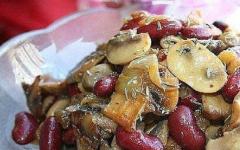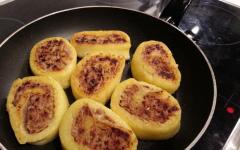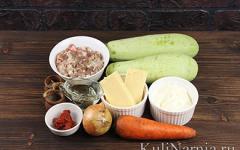From 130.00 RUR
In stock
Quantity:
Description
Without a doubt, the most famous flavored tea in China is straight from Fujian. Luxurious high-mountain green tea with jasmine, with a sweet taste and delicate, refined aroma. AND
made using technology , inheritedfrom tea mastersSong Dynasty (960–1279), when jasmine tea was reserved for the imperial court.The birthplace of green jasmine tea (Moli Hua Cha) according to China 茉莉花茶 is considered to be the north of Fujian province - the mountain plantations of Anxi County. The basis is taken from young selected leaves, which are collected in early spring. The raw materials are dried and stored until the end of summer, when the jasmine blooms. Jasmine flowers are collected at the end of the day, at which time the petals are tightly closed. In the evening, when the flowers begin to open, green tea is mixed with jasmine and stored overnight. At night, jasmine flowers open and release their scent into the tea. The natural aromatization process takes more than four hours and is repeated up to 6-7 times so that the tea fully absorbs the aroma and taste of jasmine flowers. Tea leaves absorb not only the aroma, but also moisture from fresh jasmine flowers, so after aromatization, the raw materials are dried again.
In Chinese folk medicine, jasmine is used as a medicinal plant due to its beneficial properties. Thus, green jasmine tea has absorbed all the valuable qualities of green tea and jasmine. For special popularity Moly Hua Cha In China it is revered as a folk drink. The main consumer is the north and northeast: Beijing, Tianjin, Jinan, Chengdu. There is a saying in the Middle Kingdom: “When you drink green jasmine tea, you always feel the aroma of spring.”
Taste and aroma:
Moli Hua Cha has a floral-spicy taste with a slight aroma of jasmine.
Infusion color:
Light yellow transparent.
Brewing method:

Beneficial features:
Cleanses the circulatory system and liver.
Has an anti-inflammatory effect.
Strengthens the immune system.
Removes toxins from the body.
Used as an antispasmodic.
Strengthens tooth enamel (you can brush your teeth with tea grounds).
Green tea strengthens the heart and speeds up the healing of hepatitis (A, B).
Also
When consumed regularly, Green Jasmine tea lowers blood pressure, removes salts, and prevents fatty liver. Helps with chronic fatigue and overstrain.
Read other articles about jasmine tea
:Vitaly September 12, 2019:
Moli Hua Cha - tea that sets the mood! Beautiful, clean, without fine dust, raw materials of amazing green color. Light yellow transparent infusion with a sweet, rich taste, while jasmine organically coexists without interrupting green tea, and a long, refreshing aftertaste. This tea goes well even in winter, despite the fact that I am used to drinking a completely different group of teas in the cold. The main thing is not to add too much tea leaves and not to overcook, as it is mercilessly bitter. To summarize, Moli Hua Cha is a good tea, both for yourself and as a gift to friends/relatives. Moreover, the price is more than affordable.
Denis August 16, 2019:
Very pleasant and most importantly aromatic tea. I didn't regret it.
Sergej_S September 10, 2018:
Very good tea, especially compared to other jasmine green teas I've tried. It doesn’t smell “chemical”, the aroma of jasmine is not overpowering. Green tea as a base is also complete. Surprisingly, it really calms, which is why it is best drunk in the evening. In the morning it somehow doesn’t work at all. I found it to be quite demanding in terms of temperature and brewing time. If you brew it with insufficiently hot water, it becomes too sweet, and if you overdo it a little, it becomes unpleasantly bitter. At some point, it becomes clear what temperature is needed and how long to keep it for each brew, and then you feel that the tea is very worthy, especially for its price.
website August 27, 2018:
New batch
Kage July 10, 2018:
I’m just starting to get involved in tea culture, so I carefully chose both the tea and the quantity to try. There is no point in drinking forcefully, just like throwing away the tea itself, which has long since expired because it was forgotten in the far corner.
I saw a comment here mentioning the character Iroh and, perhaps, it was he who aroused interest in Jasmine tea.
Then there was one problem - my ignorance of where and how to buy green tea, specifically with jasmine. What I got from supermarkets and tea shops in my small town was just flavored herb. Even when it was brewed according to the specified recommendations. This turned my attention away from this type of tea for a long time.
Having seen jasmine tea here, I decided to order it to try, more as an addition to the main purchase - gaiwan.
Pleasant aroma, pleasant taste, unfolded leaves with jasmine flowers, beautiful in their simplicity, and the infusion itself has a pleasant color.
I haven’t learned to characterize the notes of taste, and therefore I won’t try to describe the whole gamut of my feelings. For me personally, tea should be a self-sufficient drink, with a pleasant aroma and taste, which does not need to be filled with sweets, and which can be drunk both alone and in company with equal pleasure. This tea matches.
Thanks DaoChai.
website June 24, 2018:
New batch spring 2018
m00n1ight February 13, 2018:
I admit, I took this tea to try with caution. It’s not that I’m afraid of spoiling my Yixing teapot with aromatization - I also have a gaiwan (and more than one - thanks to DaoChai) - but I had experience of drinking various bagged green teas from supermarkets, including jasmine. It was probably the most disgusting of all.
There is nothing like that here. A small portion of tea was brewed in a bulky silver-plated gaiwan with relatively warm water (about 80 degrees). The result was a beautiful, sweetish-smelling infusion, the softness of the taste having nothing to do with the disgusting bitterness and harshness of its packaged versions.
But still, for me, this tea is purely for my mood, and I won’t drink it every day - for that I get a minus point.
Anastasia October 15, 2017:
Great tea! Very tasty!
There is nothing to say about the aroma - jasmine jasmine!
Apparently I overexposed the first strait, it turned out a little tart for me, the other four came out just fine!
Sweetness in taste, fragrant, and ubiquitous jasmine. A very sensual tea.
I really liked it!
You really need to brew it very carefully - for the first time, take a little less than you want, and hold it for a few seconds less than you are used to.
And then you can decide according to your taste.
Moli Hua Cha tea or Moli Hua Cha is a wonderful green drink that has been made in China for over ten centuries. The basis for this noble product is delicate tea leaves and transparent jasmine petals. Fujian province is considered the birthplace of Moly Hua Cha tea, with most plantations located at least 1000 meters above sea level - on the slopes of the mountain ranges of Anxi County. According to an old legend, a unique product appeared when the emperor decided to try his favorite green drink and asked his beloved to prepare it. The woman bent over the cup, and several jasmine flowers fell into the broth, which she wove into her silky, luxurious hair. The captivating aroma of flowers mixed with the tones of green tea and amazed the ruler so much that he asked from now on to always add snow-white buds to his drink. Following the emperor, his subjects also fell in love with the refined blend, and today it is known and appreciated all over the world.
Premium tea Moli Hua Cha or Moli Hua Cha is created only from tender, young buds and leaves collected at the beginning of the season. Jasmine flower buds are cut off four times a year, and this must be done at the end of the day, when the petals close tightly. Subsequently, the flowers are mixed with tea shoots and kept in this way until the leaves are saturated with a sweet aroma, after which the buds are removed from the blend. Together with flowers, shoots can be stored from several hours to 100 days. The longer the languishing period, the richer the final bouquet will be. Depending on the ripening time of Moly Hua Cha tea, its price also changes - the most expensive and valuable are mixtures aged for the traditional hundred days.
The premium drink has a fresh taste, in which floral motifs, light shades of freshly cut grass and unobtrusive fruit accents sound subtly and elegantly. The aroma of Moly Hua Cha tea is reminiscent of the tones of a flowering meadow, thanks to which in the drink’s homeland this amazing product is associated with spring. The noble blend has a soft golden color with a delicate light green tint.
Beneficial properties of Moly Hua Cha tea
This premium drink energizes and tones, so it is recommended to drink it in the morning. The product helps prevent disruptions in the functioning of the circulatory and digestive systems, normalizes metabolism, and enhances the functioning of the body's defenses. For a long time, Moly Hua Cha tea has been used as an excellent remedy for cleansing internal organs, as it helps remove waste and toxins. In addition, the exquisite drink promotes weight loss.
How to brew Moly Hua Cha tea correctly
Brewing Moly Hua Cha tea is an important part of traditional Chinese tea drinking, because the taste of the drink depends on how correctly the procedure is carried out. Moli Hua Cha tea is brewed quite simply and has a rich taste if all the details of the process are followed. Porcelain or glass dishes are suitable for preparation, which must be doused with hot water before placing the elite mixture into it. The first infusion should be brewed for no more than 20 seconds, after which it should be drained to clean the leaves from possible dust. A teapot with a volume of 350 ml of liquid requires 7-8 g of dry tea leaves. The infusion time should not exceed 30 seconds, and in total Moli Hua Cha tea can be used no more than 5-6 times.
|
|
Gutenberg tea "Moly Hua Cha" green in pyramids 12 pcs |
 |
In Fujian province, jasmine flowers are harvested four times a year. It is from them that popular tea is made Moly Hua, which uniquely combines the floral aroma with the luxurious taste of green tea. The tea leaves, which will later be flavored with jasmine, are harvested only in early spring, when they have a special taste value. It is noteworthy that the taste of tea is complemented by a floral aroma, but is not drowned out by it.
To produce Moli Hua Cha tea, tea leaves are grown at an altitude of almost a thousand meters above sea level. Before jasmine begins to bloom, tea is stored in special rooms that can be hermetically sealed. There are two ways to prepare jasmine tea. To quickly obtain products within one day, jasmine and tea are heat-treated together. This method is often used in large factories, but the taste of the tea becomes somewhat less vibrant. The second method is considered traditional; farmers use it in their small factories. The tea and jasmine are kept together for one hundred days, and then the flowers are manually removed from the mixture. With this manufacturing method, all the properties and taste of tea remain unchanged, so its cost increases significantly. This is the type of tea our company works with, which values the quality of the goods sold above all else.
It is impossible not to mention that Moli Hua jasmine tea can have a beneficial effect on a person’s physical and emotional state. Drinking this tea helps improve vision, cleanses the blood and liver, removes toxic substances from the body and normalizes various physiological processes. And in the cold season, jasmine tea is a great way to warm up.
Rules for brewing tea Moli Hua
Learn how to brew jasmine tea correctly Moly Hua It’s not difficult at all, it’s just important to know and follow a few simple rules. A glass teapot, flask or gaiwan is suitable for brewing; the dishes need to be warmed up before starting the process. To do this, just pour boiling water over it. Place 5-7 g of tea leaves into a heated vessel (this norm is calculated for a volume of 100-120 ml), fill it with water at a temperature of 80-90 g and leave for 30-40 seconds. The first brew should be drained; it only serves to rinse the tea leaves and force them to open. In the future, tea can be brewed no more than 5-6 times, each time draining the tea leaves after 30 seconds. If you add too much tea leaves or leave it for too long, the tea will begin to taste bitter and not a trace will remain of its exquisite taste.









